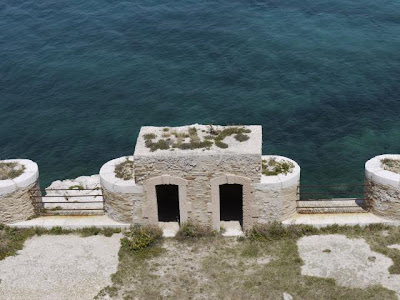Château d'If is an island in the Mediterranean Sea, just off the old harbor of Marseille. They'd be crazy if they didn't turn the place into a major tourist trap. So they've got a boat, the Edmond Dantès, ferrying tourists to the island. (Right now it's closed for construction, which will take an unspecified but large amount of time.) The island itself is rocky, like all the coast around here, with steep cliffs and a smallish fort, built to guard the entrance to Marseille's harbor with big cannons. The cannons were never used, and the fort eventually did become a prison.
It's really just a square building with a small square courtyard in the middle, and three round towers at the corners, one being taller than the others. The prison cells are dark caverns, but if a prisoner had the funds he could ask for a first-class cell that came with a fireplace, minibar, a window, and concierge service. Edmond Dantès, however, had to make do with the dungeons in the story.
Being fictional apparently didn't stop poor Edmond from digging an actual hole to the neighboring cell, an important part of the plot. They'll proudly show you the hole. To prove it's real they have TV sets showing segments from an old black-and-white movie based on the book. Edmond Dantès, As Seen On TV. In the story he takes the place of a dead fellow inmate and gets thrown over the walls into the sea, which I thought was very brave because I don't see any place where he wouldn't hit the rocks at the bottom of the walls. The TV displays do not attempt to address this problem.
Fortunately they didn't turn the whole island into a Disneyland. There are some historical displays, a gift shop, and a restaurant, but the island still feels like the forlorn rocky outpost that it once was. You can freely wander around, up to the edge of the ramparts; I didn't see a single Slippery When Wet sign. When I was there, it was mating season for the seagulls who were staging air raids on me. You can also visit several other similar islands, collectively known as the îles de Frioul, which are larger but just as forlorn and completely lack attractions. I am told bird watchers go there but my interest in birds doesn't extend beyond the edges of my plate.






No comments:
Post a Comment